[Guide] The PSP Emulators Bible! |

Benvenuto Visitatore ( Log In | Registrati )
[Guide] The PSP Emulators Bible! |
 Gruppo: Membri
Messaggi: 266 Iscritto il: Fri 25 September 2009 - 16:06 Utente Nr.: 6 Feedback: 0 (0%) 
|
Messaggio
#1
 Monday 4 July 2011 - 02:10 Monday 4 July 2011 - 02:10
The PSP Emulators Bible 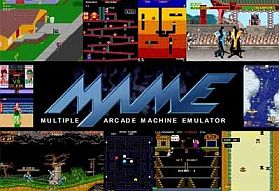 Index Chapter 1: 8 bit computers Chapter 2: 8 bit consoles & handhelds Chapter 3: 16 bit computers Chapter 4: 16 bit consoles & handhelds Chapter 5: 32 bit handhelds Chapter 6: Arcade systems Chapter 7: Other emulators PSP Emulators Bible - Official thread Introduction One of the most interesting sides of Homebrew software are certainly emulators, they allow us to bring back to life on our PSPs a lot of glorious past game machines. Emulators themselves are very often a motive which leads to buy a PSP, especially for “old school” gamers; in fact, even if, as of today the scene is filled with the so-called “open consoles” (such as Wiz, Caanoo or Dingoo and Pandora), there’s no doubt that the PSP is still one of the most powerful and convenient solutions for people who want to start exploring this fantastic world. And, even more considerably, this one remains the only handheld console to guarantee a full-speed and as good as perfect emulation of the Playstation One/PSX, thanks to the built-in emulator (the so-called POPS). This phenomenon, anyway, is costantly growing; a lot of people are starting to approach this world for the first time, asking themselves a lot of justifiable questions (the most common one is, as a reference: will it be hard to emulate this or that one machine?) or being very curious about this, also thanks to the increasingly common Chinese PMPs, which promise (at least on paper) a fantascientific emulation of lots of devices, only to be later found to be the usual low-cost devices, and with the usual emulators (often ported from the PSP ones) which we’re used to by now. And it's undoubted that today retrogaming is as popular as ever. There's no home or handheld console which doesn't have a store used to buy old titles, or old glories, to say it better. Evergreen videogames, which as of today still represent an important source of income for their respective software houses. We shouldn't be surprised, then, if the phenomenon is spreading fast, involving more and more players. Not only the "old school" ones, who lived through the times at issue, but also the younger ones, anxious to make up for the wasted time or maybe curious to try out the famous past machines people talk about so much. This "bible", then, was born for this reason, to try clearing the doubts which novice users may come across, to sum up everything that exists on PSP and that can be emulated more or less fine on our beloved handheld. At this point, someone could say that the topic has already been covered elsewhere, so why writing another guide? Well, first of all because I love the topic and I had the desire to write something about it, then because I wanted to try writing something conversational and exhaustive about this, while keeping a "tongue-in-cheek" and pleasant tone. The primary objective was therefore to deliver to the Go!PSP userbase a complete tool, from which to understand instantly which the latest version of you favorite emulator is, whether more performing emulators exist or not, and finally to group in a standalone guide all the existing PSP emulators (apart from some ancient ones, obsolete by now). The amount of emulable systems on our PSPs, among home consoles, handhelds and computers, is truly high and for this reason it's necessary to proceed systematically. In this guide we'll follow a very precise order, starting from 8bit systems (computers and consoles) to proceed with 16bit ones (computers and consoles, too) and ending with 32 and 64bit ones. Next to the title of each emulator (which will be indicated in red) you'll be able to click on the INFO button and you'll be sent to the appropriate Wikipedia page, so the most curious people or the ones who simply wish to acquire the highest possible amount of information available about that system, will only need to click on the aforementioned button. At the bottom, instead, you'll find the name of the respective PSP emulator in green, and clicking on the download button will allow you to download the most updated version. We state from the beginning that if a "signed" version of an emulator exists, it will run on whatever PSP with whatever firmware, official or custom, as if it were a Sony-created software. In the case, instead, that a "signed" version of the emulator is not available, you'll need a HEN or Custom Firmware to run it on your PSPs; I remind those of you who didn't know, that as of today (6.39 Firmware) it's possible to launch Homebrew and install Custom Firmwares on every PSP (obviously with different procedures for which you can refer to this exhaustive guide, depending on the PSP model you own). Before we start, a few "evergreen" advice: ALWAYS read the readme.txt included with each emulator to know the buttons to use and the relative button combos to activate all the functionalities of the software, apart from other useful information, such as the compatibility of the emulator itself. It might seem some trivial advice, but I assure you that the majority of people has never read a readme in their whole life. This guide, besides, doesn't guarantee to be exhaustive on the subject and represents just my personal point of view. It's a good thing to specify from the beginning that usually the folder you install emulators into doesn't change and is always "X:\PSP\GAME" (where X is obviously your memory stick). Furthermore, I remind you that using an emulator is not absolutely legal per-se, but using copyrighted material downloaded from the internet is not. THe following article wants to just have an informative purpose about the retrogaming phenomenon, and doesn't absolutely intend to bring offense to the respective copyright holders or to justify piracy. After this short, and necessary, premise I shall say that the moment has come to start examining the emulators available for the small Sony handheld! -------------------- No matter the man, we all wear masks... Either on our faces or over our hearts. Vuoi scaricare ISO e ROMz delle console più recenti? Clicca qui o qui per trovarne a bizzeffe! (Uno script non fa vedere questa frase dai mod) Pensieri: » Click to show Spoiler - click again to hide... «  |
 |
 Gruppo: Veterani
Messaggi: 1,164 Iscritto il: Mon 24 August 2009 - 15:50 Da: Nibelheim Utente Nr.: 4  Playstation Network TAG: Playstation Network TAG:silvio93 Feedback: 0 (0%) 
|
Messaggio
#2
 Friday 8 July 2011 - 10:18 Friday 8 July 2011 - 10:18
8-Bit Computers 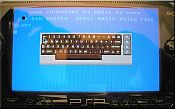 Okay, I'll admit it, I'm not impartial. I couldn't pick up a machine more loved than this one to begin with our overview of PSP emulators. It's useless to spend loads of words about the C64, one of the best selling computers of all times, an evergreen machine which even today keeps having an active scene capable of producing very impressive tech demos. I'm very happy that the good-ol' Vice was brought over to the PSP, by the way with great results. For the ones who do not know about it, the Versatile Commodore Emulator is an emulator which was ported to almost every existent OS and which is dedicated to all of the Commodore machines (so it's not exclusive to the C64) including Vic20, Plus-4, C128, Pet, C64DTV and obiviously the C64 itself. The PSP version is just a porting of the C64 emulator and it excludes all the other machines (which would be useless on our handheld). To install the package, after you have downloaded it on your PC of course, you have to decompress the archive into the folder PSP/GAME. Here you can find a piece of the original readme.txt which explains the use of the controls: » Click to show Spoiler - click again to hide... « The emulator supports disk images in the .TAP format (yes, apart from the classic disks it even supports the kiosk ones) and floppy disk images in the .D64 format. The Vice, as you can expect, works very well and it even supports the useful Savestate feature which allows you to save your progress in every moment and to resume from that point whenever you want. As for me, it's a must-have download and it cannot be missing on the memory stick of every retromaniac worth of that title. Instead, if you haven't seen the C64 in your life or you would like to re-play the best games, go to one of the most important web-sites dedicated to the Commodore console, Lemon 64. As an alternative to the PSP-Vice, you can also try the C64PSP v0.3, port of the famous Frodo emulator. This one is remarkable for the more accurate emulation of the C64 even if sometimes this affects the emulation speed, which can be solved by overclocking the PSP's CPU at 333Mhz. My advice is to keep both of them on the memory stick so if you have problems with one of them you can try the other and vice-versa. ******* 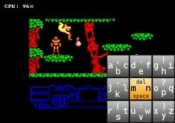 The Amstrad CPC464 is another 8bit computer, concurrent to the C64 and, if anything, born with the aim of competing with it. Actually, more than with the C64 (which remained superior as far as games are concerned) it competed with the ZX Spectrum, computer which shared the Zilog Z80 CPU with, and often game ports too. Even though this computer couldn't reach the popularity they had hoped for, it keeps being loved among those who bought it at that time or even those who re-discovered it thanks to the retrogaming phenomenon. On the PSP we can enjoy it emulated thanks to the PSPCAP32, thanks to the versatile French coder ZX-81, a port of Caprice which, apart from the CPC464, emulates the CPC664 and CPC6168 models too. This emulator runs full-speed and supports savestates; to the people who could want to delve into the Amstrad subject, I bring to your attention the excellent CPC GAME REVIEWS website, in which you'll find lots of reviews, complete with all the marks. As for the controls to use in this emulator, let's take a look at the readme: » Click to show Spoiler - click again to hide... « To install the emu, uncompress the archive to the usual PSP/GAME folder. ******* 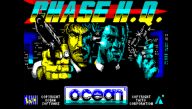 So, here we are, analyzing the other "big" of the 80s, the most famous micro computer of the age which really created the first "computer war" of the modern age, if we can call it that way. The division between "spectrumists or spectrumians" on one side and the "commodorers" on the other was sharp; you couldn't stay with two feet into one shoes. It was the marvelous era of unconsciousness, of recklessness and of the first steps of the actual videoludical industry. There was so ignorance for the topic that you could go to your newsagent to buy the famous cards which contained the original videogames (with changed names) without their protection and sold for a few bucks. Spectrum 48k was characterised by its beautiful (but a bit uncomfortable) lattex keypad, with 40 multifuncion keys. Even if it had lower hardware characteristics compared to the C64, it conquered a big slice of the market, especially in its native land, the UK, where it was created by Sir Clive Sinclair. To revive this computer into our PSP the best choice (actually, the only one) is to use the FUSE (Free Unix Spectrum Emulator) porting, created for PSP by Uberjack. It emulates all the versions of Spectrum (16k, 48k, 128k, +2, +2A, +3) and supports even the cartridges, in format .TAP and .TZX, and also the compressed disks with an extension .TRD, besided the classic snapshots in format .SNA . To install, just decompress the archive into the PSP/GAME folder. FYI, for the romantics and the interested ones, there's also another emulator dedicated to the ZX81, created by the french coder ZX81. ******* 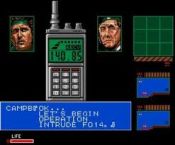 More than a computer, the MSX was a move to try to impose a new standard among the home computer's world; MSX software was developed to run on every MSX of any manufacturer. It was an experiment which produced very good results, in fact today it is still valued as an underestimated computer which has also seen a chapter of the Metal Gear saga landing on it.Different models of MSX were produced during its life cycle and it is exsitmated that it has sold about five million of computers. It can be emulated on PSP thanks to the fMSX. As for the commands, you can find a part of the readme.txt under spoiler: » Click to show Spoiler - click again to hide... « To install it, just decopress the archive into PSP/GAME folder. There is also another emulator dedicated to the MSX but it is less performant than the fMSX: PSPMSX created by ZX-81. *******  Atari was a real myth of the 80s and it continues to occupy a special place into the heart of lots of people. This emulator is very particular because, as you can read in the title, it can emulate almost every computer of the Atari family. Most of them are probably not known by the majority of the people but they are certainly the ancestors of the modern home PCs which would have come later to revolutionise the market. You can bring them back to life on your PSP thanks to the PSPAtari, porting of the famous Atari800 emulator produced by Petr Stehlik. This is the changelog of the last available version: » Click to show Spoiler - click again to hide... « ******* 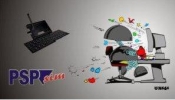 We are approaching the end of this first slide of emulators with the Sam Coupè. It is a part of those computer that can be defined "exotic", almost nobody knows them and they were created during the golden age of the 80s. The Sam Coupè belongs to that branch; it was sold mostly in Great Britain during the end of the 80s and it was considered a copy of the ZX Spectrum, which can be also emulated on the Sam coupè, and it sold only 12.000 copies. You can emulate it on your PSP thanks to the PSPSim v1.2.1 final created once more by ZX81. You will find two versions in the archive, depending on the version of the firmware used on your PSP (even if I sincerly doubt that anyone still uses the 1.50fw). This is the changelog of the final version: » Click to show Spoiler - click again to hide... « ******* 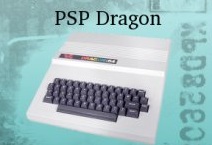 At last somebody decided to dedicate an emulator to my person! Anyway, I'll admit my ignorance, I'd never heard of this "Famous" Tandy Coco, which apparently was born to battle the C64. Sadly, the Motorola 6809's CPU make it very expensive so less attractive than the C64 itself. If you want to revive its glorious (???) deeds, you only have to download the emulator, called PSPDragon and created once again by ZX81. This is the changelog of the last version: » Click to show Spoiler - click again to hide... « ******* Another exotic computer, the Thomson MO5 is not very known to the public. Anyway, if you have the curiosity of trying it you can simply do it on your PSP with the emulator made by ZX81. This is the changelog of the last version available: » Click to show Spoiler - click again to hide... « ******* 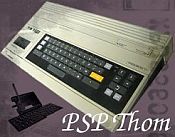 Actually, I'm not even sure this computer was even available in Italy, probably only in the hands of a few collectors. Even on Wikipedia there aren't very much information about this machine. But could you define this a bible if we didn't include the Thompson MO7 in our historical excursus? Once again, ZX81 (specialised in portings of very curious machines) gives us the chance to emulate it on our PSP thanks to PSPThom. Under the spoiler you can find the changelog of the last version available, as usual: » Click to show Spoiler - click again to hide... « ******* 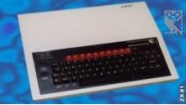 And let's close this first slide with a computer which isn't certainly famous, but it was one of the first in being commercialised, the BBC Micro Computer. Even this emulator is for the most hardcore retromaniacs, in fact I don't think that the average user could be attracted or interested. Anyway, according to the coder, this emulator isn't full-speed and probably it will never get the chance of being it because the development seems to be terminated. This are the last changes done to the emulator: » Click to show Spoiler - click again to hide... « *******
 |
 Gruppo: Veterani
Messaggi: 1,164 Iscritto il: Mon 24 August 2009 - 15:50 Da: Nibelheim Utente Nr.: 4  Playstation Network TAG: Playstation Network TAG:silvio93 Feedback: 0 (0%) 
|
Messaggio
#3
 Sunday 24 July 2011 - 11:25 Sunday 24 July 2011 - 11:25
8-bit Consoles and Handhelds 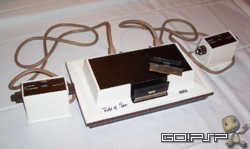 The Magnavox Odyssey is a true celebrity among consoles, not much for its sales but because it's the FIRST console to ever be commercialized, away back in 1972. Think that it came 3 years ahead of the awesome PONG; it was therefore a very ambitious project for the time, if not revolutionary. Even so, despite the initial good intentions, the Magnavox was unsuccessful because of the lacking advertisements and some commercial misjudgments (to be specific, to the public it looked like they needed a Magnavox TVs to use the console). The released games, by the way, were really few, here's the list: » Click to show Spoiler - click again to hide... « On PSP you can emulate it thanks to EmuODD, a quite old emulator of which there has been only one released version (1.0). ******* 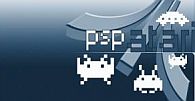 We couldn't avoid starting the 8-bit console chapter talking about the awesome Atari 2600. It's with this fantastic console, in fact, that Atari conquered the worldwide market, selling almost 30 million consoles, 120 million cartridges and earning 5 billion dollars from the project. It was an innovating product, part of the second generation of home consoles (the first was composed of the several Magnavox consoles and Breakout clones), and it was usually sold with the peculiar joysticks and paddles. What we could call the "fathers" of the modern videogames saw the light on this console, in fact, we can't forget about the portings of Mario Bros, Pitfall, Gyruss, Donkey Kong Jr, Popeye, Ms. Pacman, H.E.R.O., that is, the "hits" of those times. The console also distinguishes itself for the presence in its titlelist of what we could consider the biggest flop in the videogame history, that is, E.T. the Extraterrestrial. This game was absolutely shit and was released to ride the success of the movie, but it's needless to say that the project failed miserably. According to the legend, the millions of unsold cartridges were buried somewhere by Atari. On PSP we can play its games using the PSP2600, a Stella porting; this is the latest changelog available (from version 1.2.0): » Click to show Spoiler - click again to hide... « *******  Atari 7800 was launched on the market to regain leadership among console, thanks to the failure of Atari 5200. This console had backwards compatibility with Atari 2600 and it had a low price launch. But it had a problem. It had to fight with the Nintendo Entertainment System. The rest is history. Anyway, thanks to our PSP and to the work of ZX81, you can have a revival of its deeds with PSP7800. This is the changelog of the last version available, v1.2.0: » Click to show Spoiler - click again to hide... « ******* 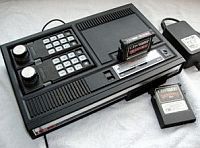 The Colecovision belongs to the category of consoles which made history. Very loved by fans, this console was launched to contrast Atari and its 2600 console. Thanks to arcade conversions, it sold lots of machines and it managed to crash the 2600 and the Intellivision, which was the most advanced machine on the market. Notwithstanding the high price of the console and the cost of cartridges (never happened, huh?) it was very prestigious. You'll find two emulators on PSP: the first one is PSPColem, which runs full-speed at 133Mhz, created by ZX81; the second one is ColemPSP, its last version being v2.6.1, created by Uberjack. This is the changelog of the last available version of PSPColem, v1.2.1: » Click to show Spoiler - click again to hide... « ******* 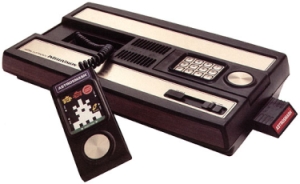 Even the Intellivison, as the Colecovision and the Atari 2600, can be considered one of the most beautiful consoles of the 80s. Produced by Mattel, everyone who has own it certainly recalls its advertising battage created for the italian launch, thought to contrast the Atari 2600. At the times, most of us owned a game like "pong" or a Atari 2600 if you were lucky enough and the Intellivision was launched on the market advertising its advanced graphics and power, compared to its opponents. Actually, the games were really cool (for the times, of course) and even today I remember with pleasure the long afternoons spent playing Maze-A-Tron or Triple Action with my friend (the mythical tanks with bouncing bullets!), with Vectron, with Soccer (my cousin and I have spent entire days with this cartridge!). Not to talk about Blackjack, the game which led the card games on consoles, really well made. The emulator is called PSPInt e this is the changelog of the last available version, the 1.1.0: » Click to show Spoiler - click again to hide... « Sadly, even if it is perfect as for emulation itself, it is not very simple or comfortable using the controls. The particularity of the console consisted in its controller, a sort of television remote control, which had a spinnable ring nut in addiction to the buttons. Every game was also provided with a pair of plastic cards which had to be inserted into the controller which had impressed the layout of the controls to use (because not every game used all the 10 buttons!). ******* 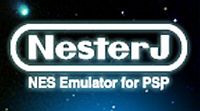 Here we are, talking about Nintendo Entertainment System, better known as NES. I think that only a few don't know this myht; it was very popular during the second half of the 80s, it was a very desired object by every child or grewing-videogamer. I remember that the high price, for the times, wasn't very appreciated but I also remember the astonishment you could feel when you could see it in action in toy stores. The most frequent comment was "it seems to be into an arcade!" and actually the system was really awesome. It was launched after the videogame market's crac and it succeeded into recovering the market; more powerful of anything seen at the times, the console gave birth to a lot of series which continue to be played today such as Zelda, Metroid, Super Mario, Excitebike, Castlevania, Mega Man, Final Fantasy, Ninja Gaiden, Dragon Quest, just to say a few. How can we forget the thug spots (obiviously in Italy) or the astonishment seeing improbable accessories such as R.O.B.? You may understand that the download of emulators dedicated to the NES is nearly compulsory; if you have lost the golden age of this console you can discover a real milestone of console history on your PSP. I correctly said emulators because there are more than one. The best is certainly the NesterJ, available even in the "RM" release which adds two interesting features which we'll talk about shortly, but even the porting of FCEU is very good and it was even recompiled to increase compatibility with games that use MMC Chip (such as FFVII hack, which doesn't work on NESTERJ). The "RM" release of NesterJ introduces two addictions: -Mirror Mode: as said by the name, allows the images to be mirrored, so for example in Mario you'll find the end of the level on your left hand side instead of the right hand side. -Rewind Mode: keeping pushed a button (R by default) you can go back in time having the shot to replay a mistaken jump, like Prince of Persia: Sands of Time. The NesterJ reads .NES or .ZIP roms which have to be inserted into the /ROMS folder inside the emulator folder; you have to create it if it isn't available. The emulator has all the "advanced" characteristics of an high-level emu. It is possible to use savestates, fix the CPU Clock, activate V-Sync and so. Personally, I've always kept it on my MemoryS tick, even today the NES games have their attraction and some of them are masterpieces so I totally advise its download. ******* 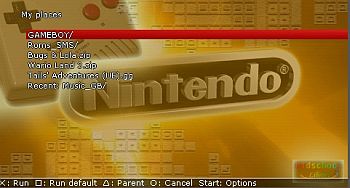 This is another milestone of the was-videoludic scene, the Master System of the never-too-much-praised SEGA. Launched about at the same time of the NES it didn't manage to oust it but it was anyway a great success for SEGA and it catched the attentions of a big group of videogamers, fascinated by the original franchises born on this little 8-bit console. How can we not talk about games like Out-Run, Ghosts'N'Goblins, Alex Kidd, Afterburner, Shinobi, Fantasy Zone, Golden Axe, Sonic The Hedgehog 2, Ultima, Wonder Boy? It's pointless to say that even at the times who owned this console compared it to the NES, unuseful console war. Anyway as you can see from the title of both consoles it was possible to see a sharp difference between the various franchises, which thanks to multiplatform titles isn't always happening today (but I don't know if it is a good thing though). Anyway, if you didn't have this piece of history you can emulate it thanks to EmuMaster (originally called Masyerboy). This is a very all-around emulator, capable of emulating lots of consoles such as Master System, Game Boy (even Super Gameboy and Game Boy Color) and Game Gear. It's a must-have for every Memory Stick; except its modularity it is also an emulator with interesting characteristics; for example it is capable of bringing back to life the games of the old Game Boy recolouring them. We are not talking about colours chosen among a palette but the emulator will colour every object giving new life to the still-enjoyable games of the little and everlasting Game Boy. It still has a few problems with GameGear games but it is nearly perfect for the rest, capable of giving a full-speed emulation of GB and Master System titles. Until the v2.02 it was developed by Brunni, the original author of the project, but after its abandonment, it was updated by other coders. The last available release is the 3.0 created by Genesis Vids, which changed the name of the project from Masterboy to EmuMaster. This is the changelog: » Click to show Spoiler - click again to hide... « ******* 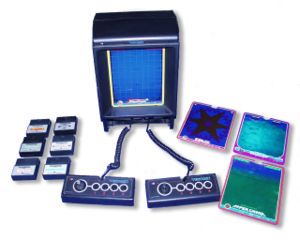 The Vectrex was a really particular console, a lot searched and a bit rare even today. As you can see on the picture, it was a console which was sold with its little incorporated monitor and two joysticks with four buttons. The peculiarity of this console, which can be guessed by its name, was its vectorial graphic such as the bar classics as Asteroids or Battlezone. And this characteristic will be an unicum in the home-consoles panorama because no one after that will repropose it. As you can imagine, it didn't have a great success, actually its sales were very low. For this reason it is still very searched by collectionists, as we said previously. If you want to bring it back to life on your PSP you only have to download the PSP-VE emulator. This is the last changelog available: » Click to show Spoiler - click again to hide... « ******* 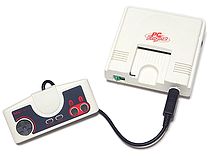 Ladies and Gentlemen, lay your hat down for the Pc-Engine, one of my favourite consoles ever. I have to admit it, when you saw the reviews of the games of this console on The Games Machine I got very envious. It was as beautiful as not very widespread in the Occident, the Pc-Engine was the result of the shared work between NEC and Hudson Soft and it was launched in Japan in 1987. The conversion of R-type was epic on this console, which is often remembered as a 16-bit console while actually its CPU was an 8-bit one. Although it was never launched in large scale on the PAL market, lots of people imported it a real high prices for the times. There are at least three emulators on PSP, capable of letting you try the emotions that this system could give. The one that I prefer, as for its performances, is the PCE for PSP, even if the best emulator for handheld can be found on the GPH consoles, the Temper of Exophase, which isn't available on our PSP. The other emu available on PSP is the HUGO of ZX81, which is not that bad, but I still prefer the PCE. If you are among the lucky ones who own this console, thanks to the tools included into the archive of PCE for PSP you can even convert your (precious) original games in CD-Rom; the emulator in fact supports even .ISO files obtained that way. Setup the PCE to get the best performances To get the best performances from this emulator you'll have to spend two minutes of time to set it up properly. The default setting do not permit to enjoy the full-speed emulation at zero frameskip. Step 1) After you have loaded a game with the button O, press the button L to enter the emulator menu (as you can see looking the high writing on the left hand side this is the 1/5 page); Step 2) Select "autoframeskip" and set it to 0; Step 3) Select "skip level" and set it on auto; Step 4) Select "Vsync Wait" and set it on ON; Step 5) Select "Video Mode" and set it on "1:1 290x272 PCEP" (it's only an advice, you are free to try other resolutions); Step 6) Push R for four times until getting to page 5/5, then select the clock of the console and set it up on 333Mhz. Now the games will run in full-speed and zero frameskip. If you prefer the simplicity and you do not want to handle lots of setting, you can use the e[mulator] which is known for its good performances concerning PC Engine. This spartan emu in fact even with its default setting is capable of giving full-speed emulation and zero frameskip. You only have to select the rom to play and it's done; obiviosly this software doesn't have the same richness of settings as the other one but at least it is simple to use. In last position in my preferences there's the HUGO. As often happens with ZX81 works, this emulator has something "imprecise" which means that sometimes when playing you could notice graphic glitches or imperfections. Anyway it is whorty to download and keep all three of them on your Memory Stick, if you are keen on this console. *******  We couldn't start the section dedicated to the 8-bit handheld without talking about the mythical Gameboy, the gray brick, the console that maybe more than any other one has invented the handheld market. Just think that the Gameboy and the Gameboy Color have sold something about 118 millions of samples in all the world. And just think that when it was launched there was a kind of scepticism around it! Scepticism that was fed mostly by Atari which launched the Lynx almost at the same time and which seemed a lot superior as for performances and graphic compared to the little one made by Nintendo. But you know, non all the donuts came with holes and in the end the designing flaws (batteries that didn't last a lot, dimensions far from portable, high price of the console and games) finished to bring down the Atari console leaving very soon open field to the Gameboy which pratically became a standard. To emulate Gameboy and Gameboy Color on our PSP well have different possibilities, offered by different emulators. As said previously, in the Master System section, the first emulator you can use is the EmuMaster (ex Masterboy), a multi-platform emulator. There are also other two emulators, a bit older than this one, which aren't capable of the other features of the EmuMaster (which will colour every object present on the screen), but both good and capable of giving a full-speed emulation. I'm talking about Homer's RIN and a modified version of this one which adds the "RM" features (Rewind and Mirror): -Mirror Mode: as said by the name, allows the images to be mirrored, so for example in Mario you'll find the end of the level on your left hand side instead of the right hand side. -Rewind Mode: keeping pushed a button (R by default) you can go back in time having the shot to replay a mistaken jump, like Prince of Persia: Sands of Time. 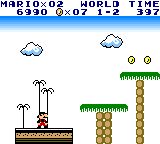 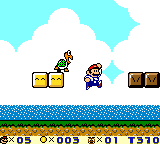 Why don't you download all three of them (also thanks to their little requirement of space) on your Memory Stick? ******* 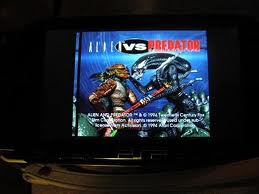 The Atari Lynx was a very innovative console for its times. As said previously, at least at the beginnings, the match with the Gameboy of Nintendo seemed almost embarassing; in fact the Lynx could count on a fantastic backlighted and colored screen (while the Gameboy, as you know, was pratically monocromathic) and could count on complex graphic effects, such as even the 3D. But as often happens in this evil field, superior hardware isn't enough to beat you opponents. And this is what happened to the Lynx which was defeated by the Gameboy; the console made by Nintendo was more comfortable to carry on and was less needy as for the batteries. In fact to use the Lynx you needed six AA batteries which lasted at maximux 4-5 hours. If you want to replay your old cartridges on your PSP you can do it thanks to PLynx, porting of the good emulator Handy. Just be careful because it is an old emulator which is not updated since 2007 and it could not work on the last firmwares. As an alternative, you can use PSP Handy which supports the more recent 3.X firmwares, even if the performances are not exciting. In fact some games have frameskip and in other the sound croacks. Sadly it is a no longer updated emulator. *******  The Game Gear belongs to the branch of handhelds launched to contrast Gameboy predominancy. Lots of us remember it for the beautiful TV Tuner which was constantly advertised and which permitted to transform your console into a little portable TV. As for the hardware, the console was a step forward the Gameboy (not that it required much) but the hardware innovations weren't enough for its success. Launched some years after the Gameboy, it didn't manage to fill the gap which led SEGA to consider it a failure. Anyway the console had good sales (11 millions of pieces sold) overcoming its opponent, the Atari Lynx. You can emulate it on your PSP with, as said before, EmuMaster (also known as Masterboy). *******
 |
 Gruppo: Veterani
Messaggi: 1,164 Iscritto il: Mon 24 August 2009 - 15:50 Da: Nibelheim Utente Nr.: 4  Playstation Network TAG: Playstation Network TAG:silvio93 Feedback: 0 (0%) 
|
Messaggio
#4
 Tuesday 26 July 2011 - 17:40 Tuesday 26 July 2011 - 17:40
16-bit Computers 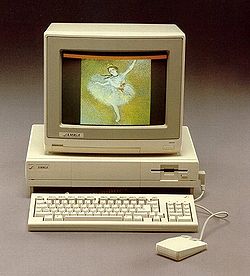 And here come my heartfelt reasons. When I have to talk about the Amiga, I admit it, I can't be objective; I can state without any fear of being wrong that I LOVE this computer, completely, as if it were a close relative, a brother or a sister. Maybe it's the most complete expression of the genius, a computer which, more than every other one could create generations of talented people, people that nowadays work in the "top level" videogame industry. There's no prominent figure in said industry who didn't go through the Amiga during the '80 and '90 decades, I assure you. Let's not even talk then about the subcultures generated by this computer, such as the Demo Scene ( Amiga's name is also tied to its extensive videogame collection, which saw the light during its long life. Unforgettable series such as Shadow of the Beast, Turrican, Lotus Esprit Turbo Challenge, Lemmings, Sensible Soccer, Cannon Fodder, Alien Breed, the Lucas and Supercars adventures or the several Pinball Dream titles, Pinball Fantasies from Digital Illusions CE, the Cinemaware games, the Delphine adventures (especially Future Wars!) are gems which still today deserve to be enjoyed and replayed. Unfortunately, and I mean it, much to my regret I have to acknowledge that, as of today, with the probable expection of Pandora (even if it hasn't a definitive emulator either) no portable console can emulate the machine at hand perfectly. First of all, I think it's an hardware complexity issue; the Amiga was a computer with many dedicated chips, which I don't imagine as being that simple to emulate in an optimal way. For this reason, for completeness about the subject, I have to bring to the attention of the interested people that the best portable emulator (from a speed point of view, since the PSP one is more feature-filled) is the privilege of Wiz and Caanoo; on the GPH consoles, surely enough, the majority of games runs well or very well, almost with no frameskip, obviously this depends on the requisites each single game had. What about the PSP? It's quite fine, I'd say. Thanks to the tireless efforts of FOL and his team, the PSP-UAE reached an excellent performance. Let's say that the majority of games will be playable with a frameskip of 1 or 2 with sound enabled, and the final result won't be too far away from the original (I say it again, it depends on the game!). As far as the several adventure games are concerned, instead, you'll be able to enjoy them with not many issues. I replayed from the beginning to the end the fabulous Future Wars without any hitch and with savestate support. In any case it's a must-have piece of software to keep in whatever Memory Stick, in view of the importance of the emulated machine and its enormous game library. A little advice to install this emulator correctly: the latest available version, 0.80 beta 13, contains in its archive just the EBOOT.PBP. Download an older release in order to get the correct folder structure and then place your 1.3 kickstart renamed to Kick.ROM in the Kicks directory. ******* 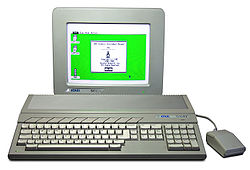 Like every King who wants to be called as such, the Amiga had its opponents and the Atari-St was surely enough the strongest one to contend the Amiga's crown, without too much success. This powerful Atari computer has been a long-time favorite for musicians, since it had built-in MIDI ports, allowing everyone, professionals or not, to set-up a personal music studio without spending that much. Unlike the Amiga, then, the Atari-ST couldn't rely on dedicated chips, such as the sound one, so its native audio was more or less like the C64 one. It had plenty of arrows in its bow though; it was less expensive than an Amiga or Mac and it shipped with 512 KBs of RAM from the factory, apart from the already mentioned built-in MIDI ports. As far as videogaming is concerned, very often games were released both in Amiga and Atari-ST versions, but the Amiga ones almost always got better scores in periodic publications, mainly because of the better audio component. The PSP emulator is called CaSTaway and works very well, since it makes almost all games run full-speed. To make it work you've to get ahold of the Atari ST TOS.ROM file and place it in the ATARI-ST directory.  |
 Gruppo: Veterani
Messaggi: 1,164 Iscritto il: Mon 24 August 2009 - 15:50 Da: Nibelheim Utente Nr.: 4  Playstation Network TAG: Playstation Network TAG:silvio93 Feedback: 0 (0%) 
|
Messaggio
#5
 Tuesday 26 July 2011 - 17:44 Tuesday 26 July 2011 - 17:44
16-bit Console and Handheld 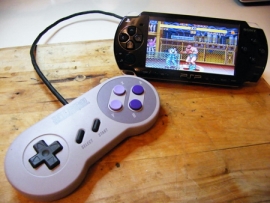 The Super Nintendo was the dominant of the 16-bit console scene, clashing with the erstwhile rival, the SEGA Genesis renamed by us with the more trivial "Megadrive". It was with no doubts a wonderful console, with a very variegated titles list and full of absolute masterpieces; in fact how not to quote the several Super Metroid, Zelda: A Link to the Past, Super Mario World, Street Fighter 2, International Superstar Soccer, Donkey Kong Country, Chrono Trigger, the Dragon Quest series, Secret of Mana, the Final Fantasy series, Super Mario Kart and many many more that quoting, even just a part, would be really impossible for the vastness of the game catalogue which the SNES had. We need to do a due assumption: the most performant emulator can once again be found on GPH consoles that can enjoy the Pocketsnes, capable of running almost the majority of Super Nintendo games in full-speed. The situation on PSP is still good, the SNES9XTYL emulator is capable of giving a good performance, on condition that it gets configured correctly. The advice is to try each time, because usually every rom can require different settings to run well. Realistically with the majority of the games you shouldn't have fluency and/or compatibility problems, and the emulator should run full-speed with zero framekskip. Clearly with the "heavier" roms, or those which use "special" chips that sometimes were inserted in Super Nintendo cartridges the situation could require beyond some tweaks, trying to gain precious FPS. You roms have to be inserted in the subdirectory folder Roms, and can be in .smc format or even zipped. Once you have launched the emulator, using the Square button you'll run the roms with the default settings, while using the Circle one you'll run them with the settings that little by little you can arrange for each rom (as said, every game needs its own configuration to run well). From any game, using the Home button you'll get back to the emulator's Menu. These are the ingame buttons: » Click to show Spoiler - click again to hide... « Particularities of the emulator and menu settings The Snesadvance.dat file, contained in the DATA folder is very important because contains specific hacks for every single rom, to make sure they run well. When you'll load the rom, FOUND SPEEDHACK will appear, in case it's supported. By opening this file with wordpad, you'll see the list of every supported rom: you'll then be able to choose the right one, since for any game there could be more than one version. As we've noticed, anyway, speedhacks are mostly available for games in the NTSC USA format. SOUND 3 options: Not Emulated (higher velocity); Emulated,no output (for games which don't run without emulated audio, since they have synchronization between Audio and CPU); Emulated,Output (the prefered option if you're interested in the sound). Afterwards you can set up the audio frequency: the higher the value, the better the sound quality is going to be. My advice is to keep it at least 22kHz. Lowering these values results in an increase of FPS ingame and so a higher fluency. VIDEO The accurate sotfware is used in the snes9x too. It's the most accurate but also slow with some games. The approx sotfware doesn't use some rendering options, obviously in behalf of speed. PSP accellerated supports with the PSP hardware a lot of the SNES graphic effects. Normally it is advisable to enable PSP accellerated + accurate software, or if you notice too many delays Psp Accellerated+ approx (risking though that some graphic effects don't work properly). Speed limit switch e speed limit fps yes makes sure that the emulation speed doesn't exceed the real one. Frameskip Rigorously leave it on 0, you can increase it in case of frameskip. You can also set it on AUTO, especially if the game is afflicted by delays in several circumstances. VSync Video synchronization : it's the scrolling of the screen. If enabled the graphic render is higher, however some games might delay. Usually if the effect isn't irritating it can be disabled. MISC – PSP Clockspeed Set the CPU clock at 333 Mhz. MISC – Hack/debug menu Speed hacks must be on ON to exploit the supernesadvance.dat file. Two different versions are available for the download of this emulator. The TYL version leans on the last existing official version 0.4.2 ME, adding improvements and several hacks. On the other hand the Euphoria version is more updated, but by coders who weren't part of the original team, although honestly the Euphoria version is maybe a little less stable than the other one. As usual the advice is to download both of them and try the game you're interested in with each version of the emulator. ******* 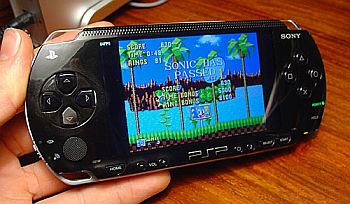 The SEGA Mega Drive was, for a very long time, the main opponent of the Super Nintendo and one of the best among SEGA consoles. Especially in european territory, being launched long before the SNES, it remained for a long time in the lead of sales rankings, ending inexorably surpassed by the Nintendo console which at the end of its vital cycle would have sold about 10 millions pieces more. In any case it's a console capable of selling 39 millions copies all over the world in a time in which the videogames didn't expand at the same level as today. The Genesis/Mega Drive gave birth to awesome series not only by SEGA, many of which are still alive in these days. Impossible not to quote masterpieces such as Sonic the Hedgehog, the Streets of Rage series, or Phantasy Star just to mention some title. But also Ecco the Dolphin, Gunstar Heroes, Golden Axe, Super Hang-On and many many more. On PSP the Mega Drive is perfectly emulated thanks to the Picodrive, superb emulator at the hands of the skilled Notaz. The emulator is practically perfect and many games run full-speed and with no problems, it also supports the SEGA Mega-Cd titles. It has to be done an assumption here too, for the sake of completeness: we must clarify that the best version of the Picodrive is available on GPH consoles; besides being more updated than the PSP version, in general the Picodrive for Wiz offers also finest performances, running full-speed with practically the entire romset. It's also available an unofficial version of the Picodrive, modified by davex, that introduces the support to REWIND (see also: emu NES); unfortunately however it's an older version of the Picodrive (1.35b) than the last one available. You may decide which one to use and download depending on your needs. As for the SEGA Mega CD titles you'll have to dump the Bios (different depending on the region of the game to emulate), and the relative files have to be placed in the same folder of the Picodrive. You can rename them as schedule: » Click to show Spoiler - click again to hide... « The games must be in ISO/MP3, CUE/CSO/MP3 or CUE/BIN format. In case you utilize CUE/BIN files, you have to load the *.cue file from the menu, or the emulator won't read the audio tracks. Clearly an ISO in a CUE/BIN format usually occupies a lot of space, so it can be converted in CUE/CSO/MP3 using the bin_to_cso_mp3 tool included in the emulator zip, whose functioning is really simple. ******* 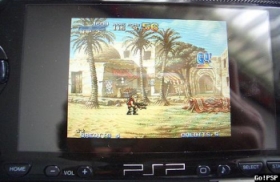 The Neo Geo from SNK was the first and only console that didn't reach a compromise, if you wanted the best, well that was the best. It gave the possibility to really have the arcade in its own house, since the respective cartridges actually contained the same games that could be admired in the various arcades. Sure, this had a really enormous cost, I would say nearly tremendous (even $200 and up per game), insomuch as the console, despite its rating, didn't spread so much. Its game catalogue was in any case exceptional, especially for the lovers of the beat 'em up genre; how not to quote the King of Fighters series, Fatal Fury, Samurai Shodown, The Last Blade, but also titles like Neo Turf Masters, Pulstar, Metal Slug and many more masterpieces that deserved out hard-earned "coins". The emulator that concerns us is the MVSPSP, available in two different versions (Fat/all the others), and gives an absolutely perfect emulation with zero frameskip. With no doubts it's one of the staples of the PSP and it's quite easy to use, once satisfied the emulator requirements. Let's see ho how to correctly set up this emulator to enjoy our old Neo Geo games. Once extracted the contents of the archive, copy the mvspsp folder in X:\psp\game\ and create in it, if it isn't present yet, the ROMS folder in which you insert your roms (in .ZIP format). Copy inside the same folder also the bios neogeo.zip, without which the emulator won't obviously work. For many games you'll then have to create a CACHE file, especially for the greedy ones in terms of ram that, we remind, particularly in the PSP Fat it's only 32MB. The CACHE file, necessary to the functioning of certain games, will be created thanks to the software Converter, contained in the romcnv folder. How to convert the roms On your PC, go in the romcnv folder and double-click on mvsconv (_slim if you have a Slim). A window with the DOS prompt will be opened, where you'll be asked to select the rom of which you want to create the CACHE. It'll be created in the subfolder CACHE. (in spoiler the DOS window) » Click to show Spoiler - click again to hide... « Once the CACHE is created (ex mslugx_cache), copy it in PSP\GAME\mvspsp\CACHE To sum up you must have: 1) in psp\game\mvspsp\roms\ the zip of you rom 2) in psp\game\mvspsp\CACHE\ the folder with the cache of the rom itself, resulting in something like this:  Now you're ready to run the emulator. One of the following problems: » Click to show Spoiler - click again to hide... « indicates an absence of the bios neogeo.zip (or of a not compatible version). To figure out if your neogeo.zip is correct, extract it and check if the neogeo folder contains all these other folders: » Click to show Spoiler - click again to hide... « ******* 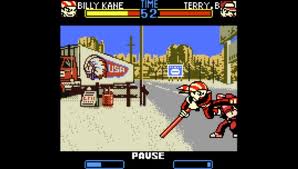 The NeoGeo Pocket/Color belongs to that group of handheld which, for one reason or another, didn't have the success that they deserved. Unfortunately it's an handheld practically unknown in the west, since it was confined to the japanese market. In its game catalogue there was surely some high-level title, such as Samurai Shodown, but as for the rest there where titles provided with low appeal for the west gamers. On PSP the best emulator available is the RACE; to make it work you'll need the Bios Rom that must be renamed NPBIOS.BIN which need to be placed in the same folder of the EBOOT.PBP. For obvious copyright reasons, it can't be included in the archive of the emulator itself. These are the buttons used during the emulation: » Click to show Spoiler - click again to hide... « The emulator also integrate the REWIND fuction; once activated it will record the last 18 seconds of your playthrough, that could be "rewinded" if there is the need and then start again from where you made a mistake. For the record we also report the existence of another Neo Geo Pocket emulator, the multiconsole e[mulator] available in version 0.82f, even if we recommend to use RACE. ******* 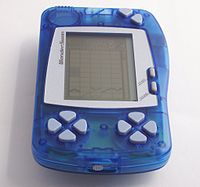 The WonderSwan from Bandai is one of those classic consoles conceived exclusively for the japanese market. Not that this is necessarily a bad thing, quite the opposite, but this type of console met specifically the tastes of the japanese gamers. It's not a case, in fact, that this platform had the support of Squaresoft which converted various titles of the Final Fantasy saga. Furthermore its shape is truly particular, since allowed the handle not only horizontally but also vertically. On PSP the only emulator that takes care of this Bandai console is the e[mulator] 0.82f with good performances, although not always we have the impression of playing in full-speed. *******
 |
 Gruppo: Veterani
Messaggi: 1,164 Iscritto il: Mon 24 August 2009 - 15:50 Da: Nibelheim Utente Nr.: 4  Playstation Network TAG: Playstation Network TAG:silvio93 Feedback: 0 (0%) 
|
Messaggio
#6
 Tuesday 26 July 2011 - 17:51 Tuesday 26 July 2011 - 17:51
32-bit Handheld 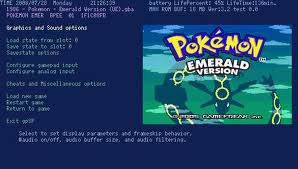 The Gameboy Advance can certainly be defined one of the most successful console created ever. Probably this isn't true for its first version which didn't have the backlight and eventually made game sessions hard to perform. Anyway from its SP restyling, the Gameboy Advance became the perfect handheld. Small enough, with a battery which lasted long, giant software titles list with enormous quality, pretty much a dream coming true. The PSP emulator is the good gpSP, created by the never-too-much-praised Exophase (the author ot the great Temper, the best PC-Engine emulator, sadly available only on Wiz) and it is without any doubt one of the best software available on PSP. It gives a pretty much perfect emulation, zero frameskip, and it even owns a series of filters which improve the image (because the aspect ratio is different from the GBA SP) and even savestates. It needs the BIOS of the Gameboy to work and it has to be named gba_bios.bin and inserted into the same folder of the emulator, which for obvious reasons of copyright cannot be distributed with the emulator itself. The official versione of the gpSP isn't updated anymore, precisely from the 0.9 release; the author in fact got bored about all the "unofficial" versions that could be found around the net and, after trying to block them speaking with the authors, had decided to stop his work. There are at least two parallel versions, not official, which are still updated. The first of them is the so-called "KAI" developed by Takka while the second one is the gpSP-J, created by an unknown japanese coder whose readme written in his native language make the understanding of the changelog difficult. Personally I'm fine using the gpSP-J but in case of problems with a certain game you can always change emulator. Generally speaking, as we said, the gpSP assures a pratically perfect and with zero frameskip emulation, with the support of the savestates. In case you decide to use the gpSP-J you could be wrong-footed by the japanese language but you don't have to worry because everything can be set in english. Let's see how. How to set the gpSP in English Step 1) Select the voice in yellow; 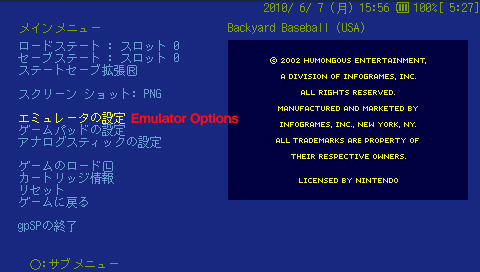 Step 2) Find the language option, which will be set on Japanese; 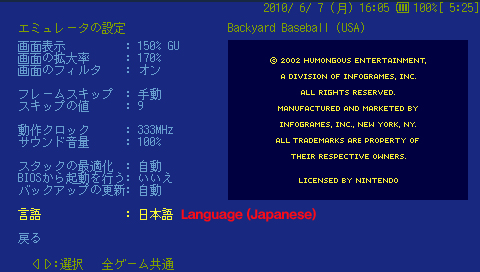 Step 3) Change the Language into English; 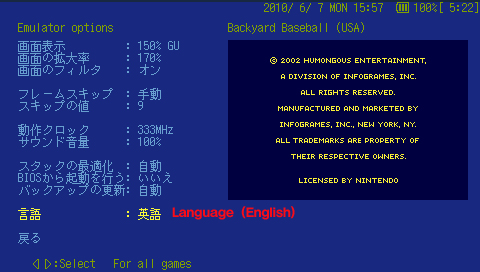 Step 4) Once you go back to the main menu reset the game (with the option in yellow) At last you'll have the menu in English: 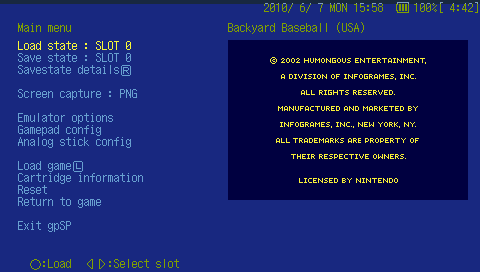 *******
 |
 Gruppo: Membri
Messaggi: 266 Iscritto il: Fri 25 September 2009 - 16:06 Utente Nr.: 6 Feedback: 0 (0%) 
|
Messaggio
#7
 Tuesday 26 July 2011 - 18:31 Tuesday 26 July 2011 - 18:31
Arcade  Acronym of Capcom Play System, the CPS cartridges were extremely popular into the Arcades and the quality of the programmed games was really exceptional for the times, in a full-Capcom style. The particularity of this system consisted in the fact that it was possible to change the game of the cabinet in a very easy way, changing the ROM on which the software resided. This emulator is pratically identical to the Neo Geo one, the MVSPSP, so I'm going to send you to that paragraph for more information, most of all for what concerns the creation of the CACHE files. As for the quality of the emulation, as for the NeoGeo, it is absolutely perfect. The games run fluid, without frameskip or delays; another must-have emulator to have on your Memory Stick. The only precaution to take is to choose the right version of CPS2 (available in two format: Fat or Slim). This emulator doesn't require any Bios to work. There are no problems for the CPS1 emulator, which only has one version. ******* 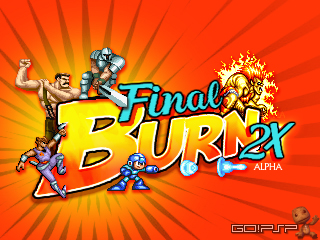 The Final Burn Alpha is a multiarcade emulator which deals with lots of masterpieces such as PGM, Cave, CPS, Seta, Sega, Konami and it works aboslutely great! This is in fact another piece of gold of the PSP's emulation scene, which helps, at least in part, the lack of the presence of a well-working MAME such as the one on the GPH consoles (Wiz and Caanoo). The project was recently updated by Oopsware and it deserves to be downloaded only to replay to some Cave shoot'em'up like Donpachi, DoDonPachi and ESP Ra.De. The romset used is the one of the MAME 0.141. Just for information, besides the last version available, we'll post the last release created by Ibicelyne. Reading the readme inserted into the two archives it seems tha the version created by Oopsware (the 20110309) will only support 55 games, while the old version created by Ibicelyne supports the entire romset of the Final Burn Alpha. ******* 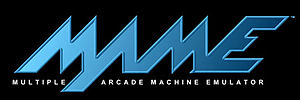 Now, let's talk about the one which probably is the most famous, known and for some verses the most charming emulator. I'm obiviously talking about the Multiple Arcade Machine Emulator, born from an idea of Nicola Salmoria who was the author of the first official project. It is an emulator of arcade gaming platforms which, almost born like a joke, has spread so much that can now emulate almost every coin-up created. Sadly, and I'm saying it with real regret, there is not a such thing as the MAME emulator which the users of Wiz and Caanoo can enjoy on their consoles (created by the great Franxis). Although the PSP version was updated several times, the performances are really far from their counterparts on the GPH consoles. In addiction, this emulator is still very uncomfortable to use because it is divided in various folders, each one of them dedicated to a different coin-up producer (such as Bandai, Capcom, Taito). We need to specify that once the archive is decompressed you'll have to install every single producer folder containing the EBOOT.PBP into the X:/PSP/GAME folder. Inside every directory you'll find a description.txt file which contains the list of the supported games, so check it to know if your favourite game is supported or not. We have to specify that not every rom will work for this emulator, but only the ones compressed of the 0.97 romset. *******
-------------------- No matter the man, we all wear masks... Either on our faces or over our hearts. Vuoi scaricare ISO e ROMz delle console più recenti? Clicca qui o qui per trovarne a bizzeffe! (Uno script non fa vedere questa frase dai mod) Pensieri: » Click to show Spoiler - click again to hide... «  |
 Gruppo: Veterani
Messaggi: 2,831 Iscritto il: Tue 25 August 2009 - 10:56 Da: Pescara Utente Nr.: 7  Playstation Network TAG: Playstation Network TAG:Giddolo Feedback: 0 (0%) 
|
Messaggio
#8
 Wednesday 3 August 2011 - 12:07 Wednesday 3 August 2011 - 12:07
Other Emulators 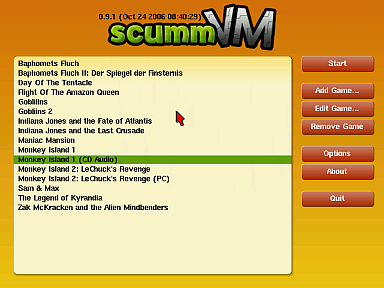 Acronym of Script Creation Utility for Maniac Mansion, the SCUMM was the most famous engine for the creation of graphic adventures which are now legends. How not to quote the various Monkey Island, Indiana Jones, Zak Mckracken, maniac Mansion and other great Lucas' adventures? This emulator has rewarded the full maturity and, in its last version, it permits to bring back to life on PSP lots of mythical adventures. The thing is made more precious by the fact that, in the meantime, some adventures are been made downloadable freely and legally so I'll say that the ScummVM enters into the category of that emulator which cannot be missed into your Memory Stick. Once you have decompressed the zip with the emulator, copy its contents into the X:/PSP/GAME folder. Copy the graphic adventures, the ones supported of course, into the same folder of the ScummVM. The first step to make it work is to let the software recognize the adventures you want to emulate. Once everything is started you'll find an orange screen; move with the analog stick on Add Game, press X, search the folder with your game (eg. Broken Sword), press X once to select (it'll become green), then press X another time on Choose in the left hand side lower corner. A little menu will be opened and you can now choose settings for language, subtitles, graphics, resolution and so on. Change the settings as you prefer then press Ok in the righ hand side lower corner. In Options, in MISC, you'll find the autosave setted on every 5 minutes. Obiviously, once you have added a game you'll permanently find it on the initial list. Go on the title you want to play and double-press X (which works like the Left button of the mouse) or highline it (pressin X once) and press START on the lower part of the screen to make it start. This are the buttons: » Click to show Spoiler - click again to hide... « In addiction, you can download on the official site of the ScummVM project masterpieces such as Beneath to Steel Ski, Lure of the Temptress, Flight of the Amazon Queen from the download section, legally. This is certainly a chance not to be missed to replay those masterpieces in an all legal way. ******* 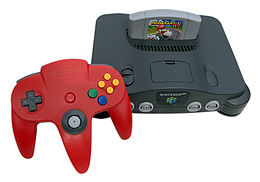 The Nintendo 64 was the console which had the difficult task of succeeding his majest the Super NES. To revive its deeds will have been hard and actually the Nintendo64, notwithstanding the good sales (almost 30 million consoles sold worldwide) didn't succeed in bissing the success of his ancestor thanks to the exploit of the PlayStation which would have sold more than 100 million of consoles. Anyway, the Nintendo64 was a console which has seen titles considered even nowadays among the most successful games of all times; games like Zelda: Ocarina of Time and Majora's Mask, and even Pilotwings64, Mario64 and other classics. It is a very powerful machine to emulate and no-one, at least at the beginning, thought it was possible to emulate it with good results on the PSP. The sceptical ones were let down because thanks to the work of StrmnNrmn before and of the Daedalus Team after, it was possible to have a quite good emulation even on the little one made by Sony. The project is far from being completed but setting it up properly it is possible to obtain good resultes and some games will be almost or entirely full-speed. Our good Kakarotto has created a thread with all the compatibility tries done by him and the right setting for the tested ROMs. ******* 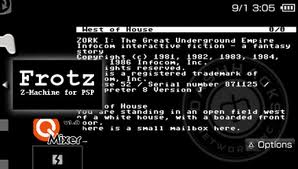 I know that many of you are probably wondering "what the heck is this Z-Machine?". Actually only the older ones will have the answer to this question. It is a virtual machine created during the distant 1979 used by Infocom for its textual adventures. It pointless to say that it is an emulator dedicated to the true retrogamers, in the most pure significant of the term. I cannot imagine a retrogaming more retro than this one, like going back to the starts of videogaming! Just a little curiosity: the Z stands for Zork, the first adventure of Infocom. The emulator is called Frotz-PSP. Here we have a piece of readme which explains how to install and to run its adventures: » Click to show Spoiler - click again to hide... « ******* 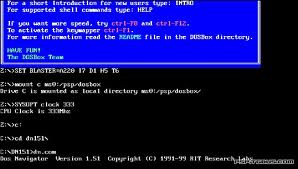 Dosbox is an abandoned project, sadly, which allows us to play on our PSP some old glories which run on the homonymous Microsoft OS. Even if it is a no more updated project, it permits to play lots of titles which run under DOS. At this link you'll find a very good list of retrocompatibility of many games which support Dosbox (concerning PSP). ******* I thank Kakarotto for his precious cooperation and the support offered during the writing of this article. The reproduction and the copy, even partial, without the author's permission is strictly forbidden outside GbaRL and Go!PSP Dragon Chan - © 2011 Go!PSP.it Translated and adapted by Davi92 and MJ2332. --------------------  |
  |

|
Versione Lo-Fi | Oggi è il: Thu 1 May 2025- 06:29 |